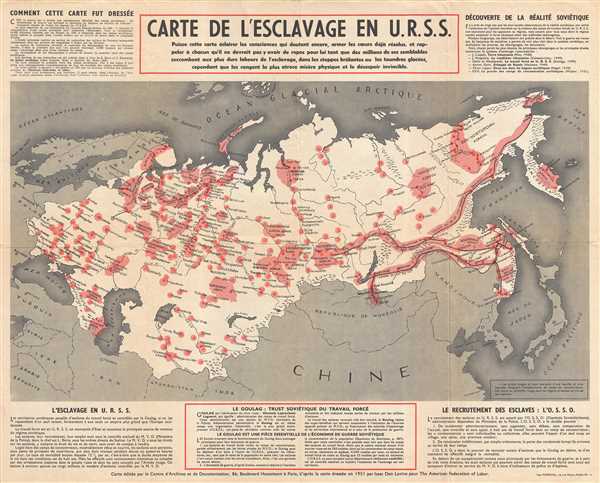This item has been sold, but you can get on the Waitlist to be notified if another example becomes available, or purchase a digital scan.
1951 French edition of American Federation of Labor Map of Soviet Slave Labor Camps
EsclavageURSS-levine-1951
Title
1951 (dated) 17.5 x 22 in (44.45 x 55.88 cm) 1 : 18200000
Description
First published in the United States, this map began as a collaboration between the American Federation of Labor and Congress of Industrial Organizations (AFL-CIO) and the United Nations Economic and Social Council (UNESCO). It was authored by Isaac Don Levine, a Russian-American journalist, who emigrated to the United States as a teenager, and underwritten by the CIA and the Department of State. First published in the anti-Communist magazine Plain Talk, soon in was published in Time. Following it's publication in Time, Voice of America (the United States government sponsored radio station) publicized it all over the world, leading to frequent requests for reprints. The map would even be used as an example of psychological warfare for Army personnel. Maps were used throughout the Cold War to try to contain the Soviet Union and stabilize relationships between nations.
Several different editions of this map were circulated, including editions with photocopies of inmates' official release certificates along the margins, or photos of inmates added along the bottom border. This edition was edited by the Centre d'Archives et de Documentation in Paris from the original drawn by Isaac Don Lewis for the American Federation of Labor. Few examples of this map exist in institutional collections and it is rarely seen on the market, making this a unique find for Cold War collections.
Cartographer
Isaac Don Levine (January 19, 1892 – February 15, 1981) was an American journalist. Born in Russia, Levine came to the United States in 1911. After finishing high school in Missouri, he began working for The Kansas City Star and then The New York Herald Tribune. He covered the Russian Revolution of 1917 for the Tribune and the Russian Civil War in the 1920s for The Chicago Daily News. He was a columnist for the papers of Hearst papers during the 1920s and 1930s. In 1939, Levine collaborated with famed defector Walter Krivitsky, a chief of military intelligence. Levine was the ghostwriter for a series of articles penned by Krivitsky about Stalinist Russia and his escape. Levine served the editor of Plain Talk, an anti-Communist magazine, from 1945-1950. He also played a role in the case against Alger Hiss, a State Department employee, who stood accused of being a Communist courier. More by this mapmaker...

